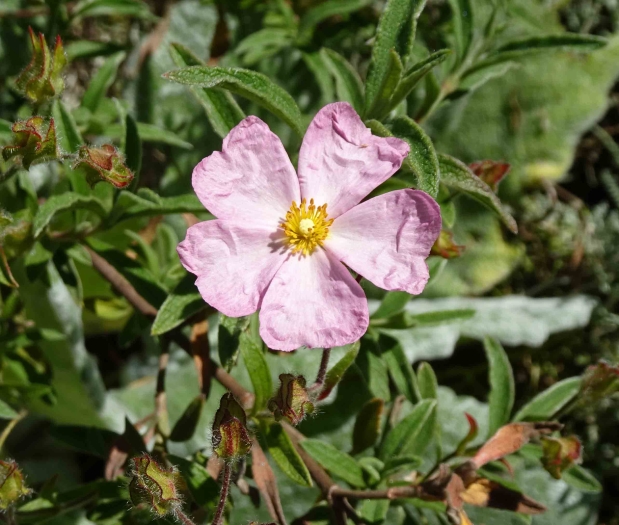Dwarf Pink Rockrose
(Cistus ×skanbergii)
Dwarf Pink Rockrose (Cistus ×skanbergii)
/
/

阿橋 HQ
CC BY-SA 2.0
Image By:
阿橋 HQ
Recorded By:
Copyright:
CC BY-SA 2.0
Copyright Notice:
Photo by: 阿橋 HQ | License Type: CC BY-SA 2.0 | License URL: https://creativecommons.org/licenses/by-sa/2.0 | Uploader: Rudolphous | Publisher: Wikimedia Commons | Title: 岩薔薇屬_Cistus_x_skanbergii_-溫哥華植物園_VanDusen_Botanical_Garden,_Vancouver-_(9219877937).jpg | Notes: == {{int:filedesc}} == {{Information |Description=Male catkins and little pink female flowers. Comptonia used to be included in Myrica, like our native sweet gale (Myrica gale). It comes from Eastern North Ame






Estimated Native Range
Summary
Cistus ×skanbergii, commonly known as Dwarf Pink Rockrose, is an evergreen shrub that is a hybrid likely originating from the Mediterranean region, with particular associations to Italy and Greece. It was first described by Italian botanist Michele Lojacono Pojero in 1885, who named it after his colleague, Swedish botanist Alexander Skånberg. Despite the overlapping native range of its parent species, Cistus monspeliensis and Cistus parviflorus, Dwarf Pink Rockrose is infrequently encountered in the wild. This compact, bushy variety reaches 2 to 4 feet in height and spreads 4 to 6 feet wide, featuring soft, grey-green leaves. From spring to early summer, it produces 1-inch wide, pale pink flowers with prominent yellow stamens at the center, adding a delicate splash of color to the garden.
Dwarf Pink Rockrose is valued for its drought tolerance, low maintenance requirements, and the soft, pastel hue of its flowers. It is well-suited for rock gardens, coastal plantings, and Mediterranean-themed landscapes. Its ability to thrive in full sun, with minimal water once established, and in well-drained soils makes it a popular choice for water-wise gardens. While it is generally disease-resistant, it can be susceptible to root rot in poorly drained soils.CC BY-SA 4.0
Dwarf Pink Rockrose is valued for its drought tolerance, low maintenance requirements, and the soft, pastel hue of its flowers. It is well-suited for rock gardens, coastal plantings, and Mediterranean-themed landscapes. Its ability to thrive in full sun, with minimal water once established, and in well-drained soils makes it a popular choice for water-wise gardens. While it is generally disease-resistant, it can be susceptible to root rot in poorly drained soils.CC BY-SA 4.0
Plant Description
- Plant Type: Shrub
- Height: 2-4.5 feet
- Width: 2-3 feet
- Growth Rate: Moderate
- Flower Color: Pink
- Flowering Season: Spring
- Leaf Retention: Evergreen
Growth Requirements
- Sun: Full Sun
- Water: Low
- Drainage: Medium
Common Uses
Bank Stabilization, Bee Garden, Bird Garden, Border Plant, Butterfly Garden, Drought Tolerant, Groundcover, Low Maintenance, Rock Garden, Salt Tolerant, Showy Flowers, Street Planting
Natural Habitat
Mediterranean region, particularly Italy and Greece
Other Names
Common Names:
Scientific Names: Cistus ×skanbergii , Cistus ×skanbergii f. albiflorus
GBIF Accepted Name: Cistus ×skanbergii Lojac.